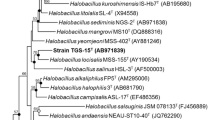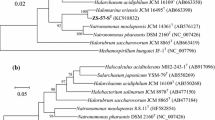Abstract
Two halophilic archaea, strains GX21T and R35T, were isolated from a marine solar saltern and an aquaculture farm in China, respectively. Cells of the two strains were observed to be pleomorphic, flat, to contain gas vesicles, stain Gram-negative and produce red-pigmented colonies. Strain GX21T was found to be able to grow at 25–50 °C (optimum 37 °C), at 2.6–4.8 M NaCl (optimum 3.4 M NaCl), at 0.05–1.0 M MgCl2 (optimum 0.1 M MgCl2) and at pH 6.0–8.5 (optimum pH 6.5) while strain R35T was found to be able to grow at 25–45 °C (optimum 37 °C), at 2.1–4.8 M NaCl (optimum 3.1 M NaCl), at 0–0.7 M MgCl2 (optimum 0.03 M MgCl2) and at pH 5.5–9.5 (optimum pH 6.5–7.0). The cells of both isolates were observed to lyse in distilled water. The minimum NaCl concentrations that prevented cell lysis were determined to be 15 % (w/v) for strain GX21T and 12 % (w/v) for strain R35T. The major polar lipids of the two strains were identified as phosphatidylglycerol, phosphatidylglycerol phosphate methyl ester, phosphatidylglycerol sulfate, one major glycolipid and a minor lipid chromatographically identical to sulfated mannosyl glucosyl diether and mannosyl glucosyl diether, respectively. 16S rRNA gene sequence analysis revealed that strains GX21T and R35T show 97.1 % sequence similarity to each other and are closely related to Haloplanus aerogenes TBN37T (96.8 and 95.8 %), Haloplanus vescus RO5-8T (96.7 and 96.1 %), Haloplanus salinus YGH66T (96.4 and 95.8 %) and Haloplanus natans JCM 14081T (96.3 and 95.4 %). The rpoB′ gene similarity between strains GX21T and R35T is 90.5 % and show 88.5–90.8 % similarity to the Haloplanus species with validly published names. The DNA G+C content of strain GX21T and R35T were determined to be 65.8 and 66.0 mol%, respectively. The DNA–DNA hybridization values between strain GX21T and strain R35T, and the two strains with the Haloplanus species with validly published names, showed less than 50 % DNA–DNA relatedness. It was concluded that strain GX21T (=CGMCC 1.10456T = JCM 17092T) and strain R35T (=CGMCC 1.10594 T = JCM 17271T) represent two new species of Haloplanus, for which the names Haloplanus litoreus sp. nov. and Haloplanus ruber sp. nov. are proposed.

Similar content being viewed by others
References
Cui H-L, Lin Z-Y, Dong Y, Zhou P-J, Liu S-J (2007) Halorubrum litoreum sp. nov., an extremely halophilic archaeon from a solar saltern. Int J Syst Evol Microbiol 57:2204–2206
Cui HL, Zhou PJ, Oren A, Liu SJ (2009) Intraspecific polymorphism of 16S rRNA genes in two halophilic archaeal genera, Haloarcula and Halomicrobium. Extremophiles 13:31–37
Cui HL, Gao X, Li XY, Xu XW, Zhou YG, Liu HC, Zhou PJ (2010a) Haloplanus vescus sp. nov., an extremely halophilic archaeon from a marine solar saltern, and emended description of the genus Haloplanus. Int J Syst Evol Microbiol 60:1824–1827
Cui HL, Gao X, Yang X, Xu XW (2010b) Halorussus rarus gen. nov., sp. nov., a new member of the family Halobacteriaceae isolated from a marine solar saltern. Extremophiles 14:493–499
Cui HL, Gao X, Yang X, Xu XW (2011a) Haloplanus aerogenes sp. nov., an extremely halophilic archaeon from a marine solar saltern. Int J Syst Evol Microbiol 61:965–968
Cui H-L, Yang X, Mou YZ (2011b) Salinarchaeum laminariae gen. nov., sp. nov.: a new member of the family Halobacteriaceae isolated from salted brown alga Laminaria. Extremophiles 15:625–631
De Ley J, Cattoir H, Reynaerts A (1970) The quantitative measurement of DNA hybridization from renaturation rates. Eur J Biochem 12:133–142
Dussault HP (1955) An improved technique for staining red halophilic bacteria. J Bacteriol 70:484–485
Elevi Bardavid R, Mana L, Oren A (2007) Haloplanus natans gen. nov., sp. nov., an extremely halophilic, gas-vacuolate archaeon isolated from Dead Sea-Red Sea water mixtures in experimental outdoor ponds. Int J Syst Evol Microbiol 57:780–783
Gonzalez C, Gutierrez C, Ramirez C (1978) Halobacterium vallismortis sp. nov. an amylolytic and carbohydrate-metabolizing, extremely halophilic bacterium. Can J Microbiol 24:710–715
Gutiérrez C, González C (1972) Method for simultaneous detection of proteinase and esterase activities in extremely halophilic bacteria. Appl Microbiol 24:516–517
Huß VAR, Festl H, Schleifer KH (1983) Studies on the spectrophotometric determination of DNA hybridization from renaturation rates. Syst Appl Microbiol 4:184–192
Marmur J, Doty P (1962) Determination of the base composition of deoxyribonucleic acid from its thermal denaturation temperature. J Mol Biol 5:109–118
McDade JJ, Weaver RH (1959) Rapid methods for the detection of gelatin hydrolysis. J Bacteriol 77:60–64
Minegishi H, Kamekura M, Itoh T, Echigo A, Usami R, Hashimoto T (2010) Further refinement of Halobacteriaceae phylogeny based on the full-length RNA polymerase subunit B′ (rpoB′) gene. Int J Syst Evol Microbiol 60:2398–2408
Oren A (2012) Taxonomy of the family Halobacteriaceae: a paradigm for changing concepts in prokaryote systematics. Int J Syst Evol Microbiol 62:263–271
Oren A, Ventosa A, Grant WD (1997) Proposed minimal standards for description of new taxa in the order Halobacteriales. Int J Syst Bacteriol 47:233–238
Qiu X-X, Zhao M-L, Han D, Zhang W-J, Cui H-L (2013) Haloplanus salinus sp. nov., an extremely halophilic archaeon from a Chinese marine solar saltern. Arch Microbiol 195:799–803
Stackebrandt E, Goebel BM (1994) Taxonomic note: a place for DNA–DNA reassociation and 16S rRNA sequence analysis in the present species definition in bacteriology. Int J Syst Bacteriol 44:846–849
Tamura K, Peterson D, Peterson N, Stecher G, Nei M, Kumar S (2011) MEGA5: molecular evolutionary genetics analysis using maximum likelihood, evolutionary distance, and maximum parsimony methods. Mol Biol Evol 28:2731–2739
Acknowledgments
This work was supported by the National Natural Science Foundation of China (No. 31370054), the grant from China Ocean Mineral Resources R & D Association (COMRA) Special Foundation (DY125-15-R-03), the Qinglan Project of Jiangsu Province and a project funded by the Priority Academic Program Development of Jiangsu Higher Education Institutions (PAPD).
Author information
Authors and Affiliations
Corresponding author
Electronic supplementary material
Below is the link to the electronic supplementary material.
Rights and permissions
About this article
Cite this article
Han, D., Cui, HL. Haloplanus litoreus sp. nov. and Haloplanus ruber sp. nov., from a marine solar saltern and an aquaculture farm, respectively. Antonie van Leeuwenhoek 105, 679–685 (2014). https://doi.org/10.1007/s10482-014-0123-6
Received:
Accepted:
Published:
Issue Date:
DOI: https://doi.org/10.1007/s10482-014-0123-6




